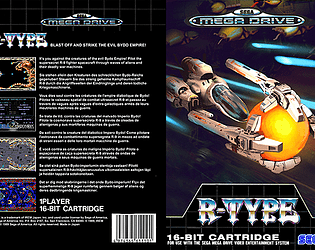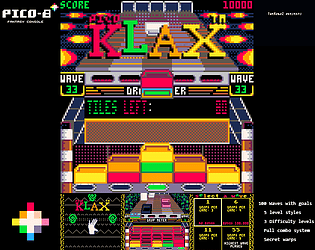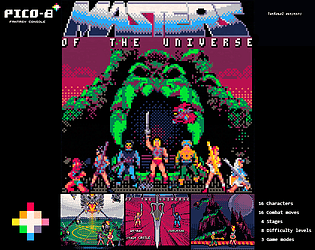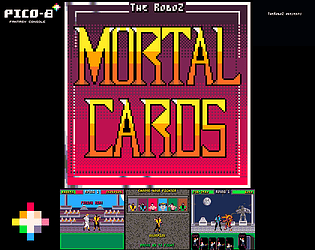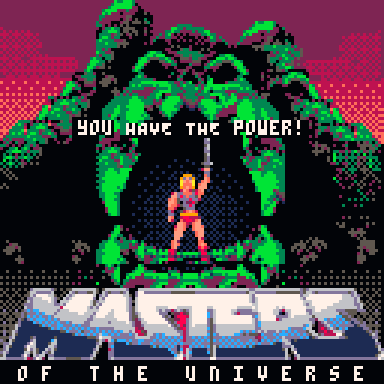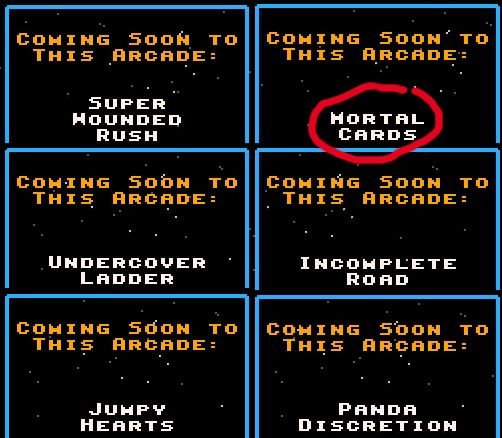Thank you!
TheRoboz
Creator of
Recent community posts
I am the same, I liked the cartoon but was more into the toys and the style of the mini comic book that came with them. One idea that couldn't make in this version due to pico space limitation but I'd like to include in a remake is "make your own character" by mixing parts from all the characters. Like with the toys you could swap arms and armors.
Thanks! No, all enemies have the same abilities, but, as the AI improves as you progress, it can react a bit faster and better. It's funny to get this question now, as a couple days ago I was thinking about a possible "16-bit" style version and one feature I was considering was exactly different damage/speed/reach for different weapons.
First of all, thanks a lot for the time put into this post, really appreciated. Yeah, some score values are still off in the demo, I get them by playing and watching videos of the arcade but having to divide the time between playing it and coding... I prioritized coding so far and just dropped in some guessed values where time was limited and I wanted a playable demo out before last year's end. Might have had a typo too that made some scores way too high. I was also hoping for some player to come along and point out some inaccuracies and that's exactly what you did and what I needed, so I can note all this and work item by item.
Some stuff is already being worked on (like the missing flipped Dobs) and some is planned for the final game but not implemented yet (like correct destruction of blue orbs in first boss). While I don't aim for a perfect arcade recreation, I want to keep fidelity as close as possible, but for some stuff, for example bosses time out (which I only discovered after releasing the demo by recording a full no-firing run to see enemy patterns) I wonder if it's better to set a default time. for this I look forward to player's input.
The only thing that is technically not possible for the time being is fading out the music before bosses, as the music driver doesn't support software volume control and in the last stage we authored the fade in the soundtrack. But this stage is the only one where it's possible because of the lack of checkpoints. we are waiting on a new music driver but it's not guaranteed it will be done before the game is finished. Everything else requires just more time.
Righty now there will not be any more public demos, to focus on completing all the missing content, but, we could use someone with this knowledge in the tester team, so let me know if you'd like to join!
Thanks!
The game needs to be rewritten for it. I thought about doing it but later. There is a proper barbarian port though, not by me. Here https://www.dropbox.com/s/o074k8vr6l0cvt0/barbarianAMIGAmegadrive.zip?dl=1
You can get it from pico-8 's forum here: https://www.lexaloffle.com/bbs/?pid=98070#p
I released a pico-8 port of klax, mainly based on the Atari Lynx version https://theroboz.itch.io/klax
Hope you'll enjoy it
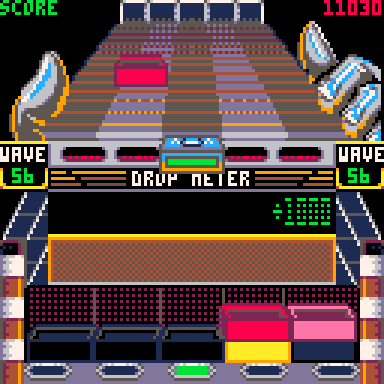
Rolling your own editor
Disclaimer: this post opinions are based on a very cursory knowledge of the Lua language
After deciding on a mixture of tile-maps and shape-drawn background styles, I needed a tool to quickly and conveniently draw these shapes, because the hand-code experiment of Grayskull was too cumbersome. I just wasn’t sure if I had enough Lua/pico-8 experience to write one.
Seeing other’s editor examples though, the temptation was too strong and I am glad I tried. Writing picoDraw was a lot quicker than I thought, the process gave me a lot of additional good ideas to implement and, most of all, it was fun!
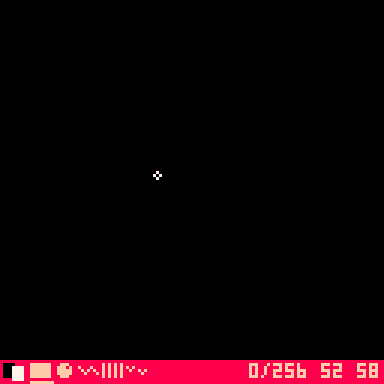
Since the drawing leverages a lot of existing pico-8 commands it was very easy to implement a working prototype, I will just highlight some details found interesting while programming and the unexpected solutions to some of my perceived difficulties:
1 – parsing and executing commands:
I am a big fan of Casey Muratori’s “write usage first” philosophy:
“you must always, always, ALWAYS start by writing some code as if you were a user trying to do the thing that the API is supposed to do”
https://caseymuratori.com/blog_0024
I worked backward from how I envisioned I was going to use picoDraw’s idealized output, a “stringified” series of command, since I already have code to extract symbol-separated data from a string for other game’s items
for simplicity I decided on using exactly pico-8 drawing function names and parameters.
cmd_list = “circ,16,16,8,1,rectfill,4,2,8,4,2,map,0,0,8,8,4,6,line,1,1,16,18,7,…”
First bit of luck was that even if gfx functions have different numbers of parameters, turns out the extra parameters are ignored, so for parsing simplicity I decided to store every function with the maximum numbers of params, 6, as in map(sx,sy,x,y,w,h):
cmd_list = “circ,16,16,8,1,0,0,rectfill,4,2,8,4,2,0,map,0,0,8,8,4,6,line,1,1,16,18,7,0…”
In this way I know each command is a series of 8 comma separated elements.
Now, how am I going to parse this into functions and parameters, in a simple way, so that I can just write something like:
draw_list(cmd_list)
I remembered seeing this pico-8 repl cart:
https://www.lexaloffle.com/bbs/?pid=71429 by user @thisismypassword
Which I thought might have some answers and turn out it did, it introduced me to the Lua _ENV variable, where turns out all function names are stored as key/value pairs, so my parsing code was incredibly simple, I just split the string into a commands table = {{“circ”,16,16,8,1,0,0},{“rectfill”,4,2,8,4,2,0}} which is also the way shapes are stored in memory and then
function draw_list(commands)
for i=1,#commands do
local cmd = commands[i]
_ENV[cmd[1]](cmd[2],cmd[3],cmd[4],cmd[5],cmd[6],cmd[7])
end
end
Right off the bat I had real-time drawing of the command list and easy parsing/ of the string output, with no special cases, no convoluted code and not a lot of token use, since this code has to run in the game too, but in game there’s a further optimization for tokens, if when I parse I store the command as the last item in the table, I can then do this:
function draw_list(commands)
for i=1,#commands do
local cmd = commands[i]
_ENV[cmd[7]](unpack(cmd))
end
end
*this code draws the complete left half of the background, map included, leveraging existing pico-8 functions. Then we just flip copy it like I explained in the previous post
As a neat side effects, it is easy to just traverse this list, drawing at each index increment, to have a nice step-by step recreation of your drawing, #putaflipinit style:

*replay of he-man’s portrait drawn by importing an image as a map (hidden here) and using it as an onionskin reference in picoDraw!
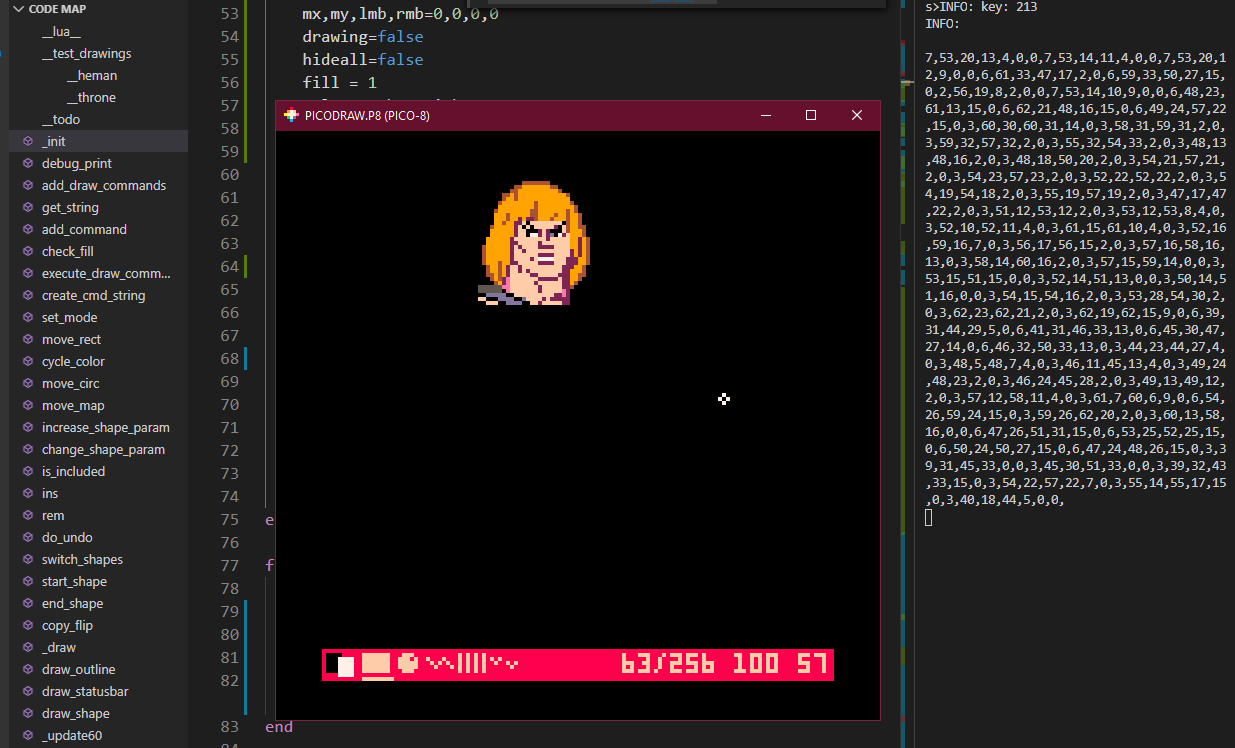
*and here is the command list “
2 – Undo function:
I was worried about implementing an undo function because I thought I was going to have to keep a stack of commands and command inverses (cmd pattern… aaaaargh!!!) or something, but looking at the console output suddenly I thought I could just save a table of cmd_string and just run an index through it, when I reach the desired undo, just parse the current string and purge all the subsequent one, in few minutes I had undo/redo working… now for sure it’s not the most elegant solution and in the long run could have bad side effects on memory but, for the current scope and usage it works pretty well and again, little code and tokens:
function do_undo(d)
cmd_string = undo[undo_index+d]
undo_index +=d
shapes={}
add_draw_commands(shapes,cmd_string) -–split string into a command table
end
3—load/save:
I knew I was going to depend on the clipboard to get the cmd_string in and out of picoDraw and while I was pasting any existing drawing in code and parsing it at init() time, @JohanPeitz showed his awesome 3d editor load/solution and gave me a code tip which made it really trivial to implement ctrl-v pasting at runtime, so now you can save and resume any drawing you want.
if k == 213 then
cmd_string,s=””,stat(4)
for i=1,#s do --sanitize pasted text
for c in all(allowed_chars) do
if (c == sub(s,i,i)) cmd_string..=sub(s,i,i) break
end
end
shapes={}
add_draw_commands(shapes,cmd_string)
else …
Look! It is almost exactly like the undo code!
All these conveniences are bonuses earned from settling on a simple data format following the usage first design (and pico-8/Lua awesomeness!)
4 – fill patterns
I was thinking of a complicated approach to this, storing a different fill command, or generating it when outputting the string but, since all commands except map still have a spare entry, I decided to just stick the eventual fillp there, so when it’s we don’t do anything and when there’s a value we apply it before drawing this shape and clear it afterward (or we can set a bool if we are in a fill or not and just clear once at first 0, this depends if we need more tokens or more speed)
cmd_list = “circ,16,16,8,1,0,0,rectfill,4,2,8,4,2,-512,map,0,0,8,8,4,6,line,1,1,16,18,7,0…” --rectfill now has a pattern applied
for i=1,#commands do
local cmd = commands[i]
if (cmd[6]!=0 and cmd[1] !=4) fillp(cmd[6] +.5) -- base pattern + transparency
_ENV[cmd[7]](unpack(cmd))
fillp()
end
5 – additional ideas:
Granted this tool is still unfinished and rough around the edges but, for a week worth of work, it was a pretty good investment for game assets creation and for personal learning. Now I am implementing some further refinements
Once oval() is available in pico-8, code will be further simplified because all the if else/ to manage circle exception will disappear, since I guess oval will use 4 params as rect and store color at the same parameter position and I won’t have to use giant circles any longer to get large, smooth curves
I think I can write a small triangle function that can fit into the existing data format, to avoid overusing rects for complex shapes, with a minimal token utilization, it should be easy to use in game too.
As you can see in the portrait examples, I switched to numbers as command, to compact output a bit, and I just do one lookup in a command table, now the execution is:
_ENV[cmd_string[cmd[7]]](unpack(cmd))
Still compact enough
I plan to encode cmd parameters length in this cmd index too, to allow variable length cmds, and save characters while not over-complicating the string splitting
My final goal is to normalize all coordinates and gradients so they can all be written as hex 00-ff allowing to store drawing data in map or sfx space, should the necessity arise
All this will be done after I progress a bit further with the game code. Now back to sprite work and game programming.
If there’s anything to learn from this post it is: Don’t be afraid to try and roll your own tools, sometimes it’s quicker than wrestling somebody else’s into doing your own bidding.
picoDraw current stats: 3500 tokens, 23100 chars
Artsy Backgrounds on the cheap
The first obstacles on this project’s development path are backgrounds.
My goal is to have at least 4, maybe 5, full screen painterly-style backgrounds similar to this 128x128 reduction of John’s original background
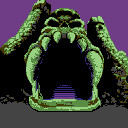
Other esoteric compression and storage solutions using map memory, sfx memory or encoding sprites in strings still end up are complicated and, no matter how I tried, a straightforward bitmap compression ended up using over 50% of available resources for a single image while adding a lot of code to handle compression/decompression and swapping, so I had to try a different approach.
this first background has a lot of black areas, some similar “blocks” who lend themselves to tiles plus a pretty handy horizontal symmetry; pico-8 gfx strengths are fast enough graphic primitives, versatile tile map, pattern fills and an interesting available slot of memory at 0x4300 - 0x5dff which I had no other idea how to use so my idea was to see if I can draw half background using as little tiles as possible and mirror it and then use some trick to mask the symmetry
the following gif shows all the steps that build the final background on pico-8 (the trick is on step-8):
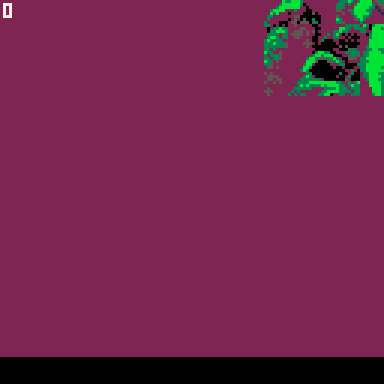
- 0-clear screen to sky color (top right shows the 20 sprite tiles used for the background, which have a lot of transparency so they can be overlaid on different background colors
- 1-add a sky gradient with a patterned filled rectangle
- 2-add black filled rectangles to lay out most of the black area
- 3-add some colored shape to fill transparent areas behind tiles and main ground area
- 4-add lighter gradient on ground
- 5-add one last shadow to be drawn under the tile map
- 6-the 20 tiles are reused in different locations to build the left half of Grayskull castle
- 7-cover some blocky edges with a black filled circle
- 8-Here we flip and draw the left side to the right but we skip the first rows of tiles since the right tower will be shorter, and we offset everything 1 pixel to the left and 1 pixel down to avoid a perfect, visible symmetry in the eyes and dome, then we copy this right half to a small work ram area that can contain at most 75% of a full framebuffer, since the right tower will be shorter anyway This step is only done once, at background switching so the CPU cost of this flip and copy is negligible
- 9-In the real draw function, called 30 times per second, we only repeat steps 1 to 7 which has little CPU cost, then we just memcopy the pre-rendered right half from work memory to the framebuffer.
- 10-With draw some of the original tiles, un-flipped over the flipped right area to mask the symmetry and complete the tower
- 11-Final black dithered pass to add some “noise” details and cover the blocky-ness
We can now add some animating effects, as clouds and mouth glows to make it more alive
Here is the final result:
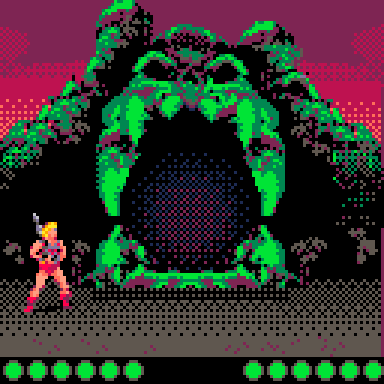
CPU cost of all this plus existing game code is around 15%, sprite used 20 (some of which I hope to re-use in other backgrounds). This gives me an approachable target of 4 or 5 background in this style while having at least 3 pages of sprites for characters and other gfx items
But now I need a comfortable way to prepare all this shape drawing code which, up to now, was hand-coded as a test.
In the next post I will discuss the custom-made solution and editor I wrote for this
A Barbarian remake for pico-8 but with a Masters of the Universe themed makeover.
Game released! Play it here: https://theroboz.itch.io/motu


